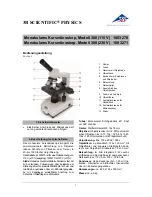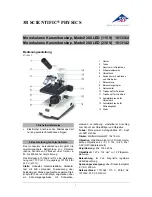
11
Changing the objective
When you reached the optimal top view with the smallest magnification (4x), turn the objective lens piece to the next magni
-
fication (10x). The objective lens piece should click into position. Only a slight adjustment should be necessary, to receive a
clear picture again. Should you increase the magnification further; the top view will be improved by adjusting the light. The
objectives have different lengths, therefore it is often necessary to adjust the height of the object stage. Elsewise the delicate
lenses could collide with the object plate and damage this in the worst case.
100x immersion oil objective
The 100x objective (oil objective) moves extremely close to the object. For that purpose the immersion oil bottle is included.
Dab a small drop of this oil onto the lens of the 100x objective, and imperatively cover the object with a cover glass! The oil
shuts the very narrow gap between the lens and the cover glass. (Please, never touch the objects with the lens!) After having
used the 100x objective, the OIL IMMEDIATELY has to be wiped off with a dust-free, soft lens cleaning paper!
Use of the object stage
The Betzold microscopes are provided with a lock for the object stage. This allows only a certain maximum height of the sta-
ge to avoid collisions with the objectives. This lock is already adjusted correctly, and should not need any further adjustment.
However, should you have the impression that you need to approach the objective nearer; you can adjust the lock yourself.
Please pay attention when doing this as damaged objectives will not be replaced, as the damage has been CAUSED BY
THE CUSTOMER!
So, always keep in mind to not screw up the object plate too high!
After use
When having finished working with the microscope, turn off the current. Use the knob for coarse adjusting to move the object
stage downwards. The device should be protected by a dust cover, or disassembled and put back into the original Styrofoam
packing.
c) Exchanging the tungsten bulb of the microscope model M-06
A tungsten bulb (220/230 Volt, 20 Watt) is required.
First pull out the power plug! Loosen the screws at the bottom of the microscope, and remove the base plate. Replace the
used bulb by a new one. Pay attention – the bulb should not be touched with your fingers, as this might shorten the operating
time. Replace the base plate.
Suggestions for the observation of specimen
Children should not experiment without adult supervision!
1. Place some grains of salt or sugar on the microscope slide.
2. Dissolve a teaspoon of salt/sugar in warm water in a test tube. Then use the pipette to place some drops on an object
holder. Let them dry and observe the recrystallization of the salt/sugar.
3. Shake some pollen of a blossom onto an empty microscope slide.
4. It is interesting to observe parts of feathers, or any hair, that of domestic animals included. Try to compare the hair of
different animals. You can fix the hair with a small piece of sticky tape onto the microscope slide.
5. Observe the fibres of different types of paper, or compare the print of a newspaper with that of a type-writer or a laser-
printer.
6. Look at the colours in comics, or at strings and fibres of different materials.
7. Compare natural fibres like cotton wool or wool, to synthetic ones like polyester.
8. Water, out of a pond, contains living organisms. Put a drop of it onto the microscope slide with the dip to observe them.
9. Very small insects can be looked at with little magnification.
10. Or try to look at parts of bigger beetles, like legs or wings. Doing this, the needle is useful for the positioning. Always
take insects with tweezers, and wash your hands carefully after handling them.
11. Watch the mould on old bread or other food. Or create your own mould culture, by putting a little piece of bread into
a petri dish for some days. A little moistness accelerates the moulding process. (Here too, wash your hands carefully
after work.)
12. Many objects seem to be transparent under the microscope. Usually these objects are dyed, to make the cells more
visible. A current dye is iodine. You can also dip your tissue sample for some minutes into normal, diluted food colouring
in order to dye it. Use a pair of tweezers to transport the dyed objects. Bear in mind that the colour will dye any objects
contacted. Therefore, take care of clothing and furniture.










































